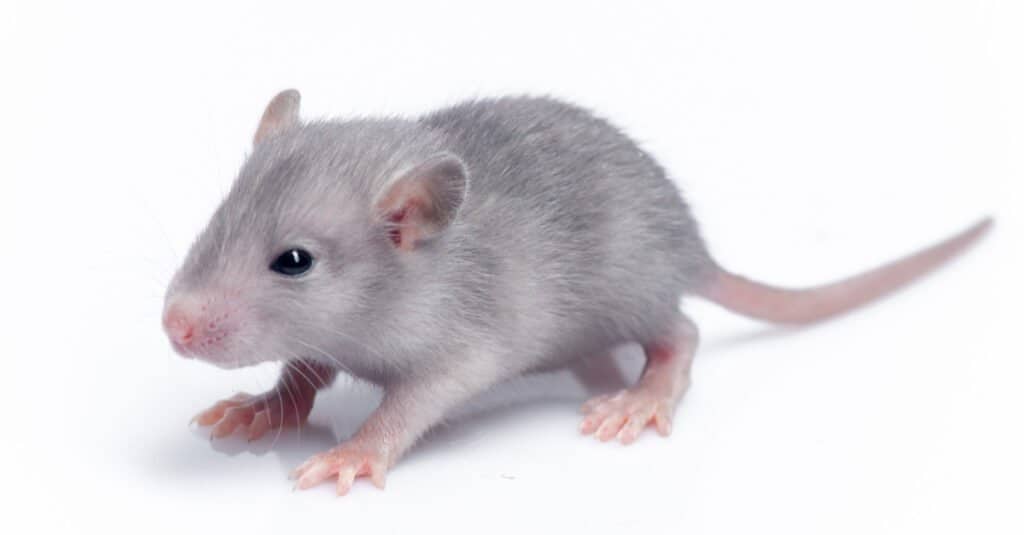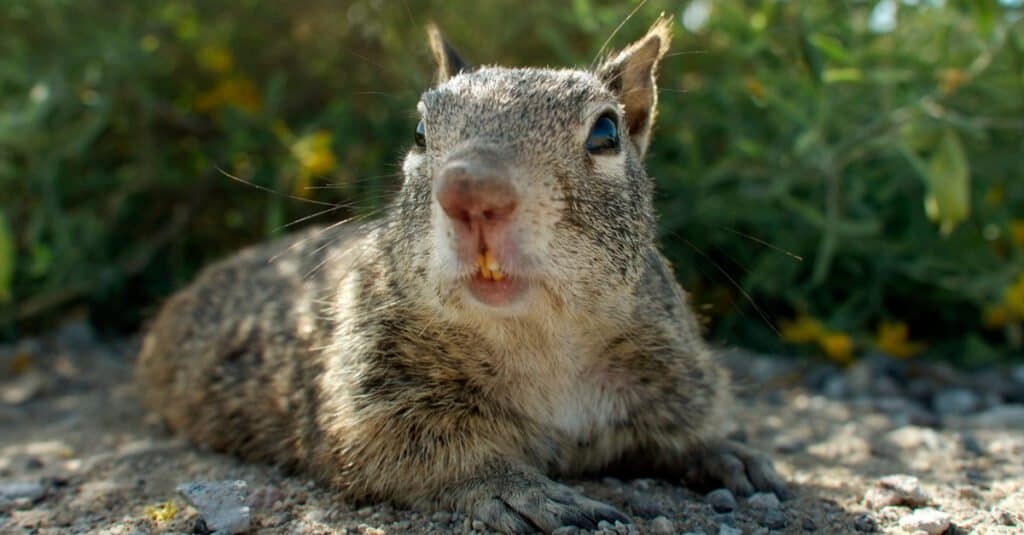Imagine that you find a little pink creature with a long tail on your back patio. You think that it might be a newborn rat. It also might be a newborn squirrel. Come to think of it, you don’t know exactly what these baby rodents are supposed to look like at all. That is why we are going to take some time to flesh out the differences between a newborn squirrel vs rat. By the time you’re finished reading this, you should have the ability to identify the creature on your patio as either a rat or a squirrel!
Comparing a Newborn Squirrel and a Rat

| Newborn Squirrel | Newborn Rat | |
| Size | Weight: 14-16 grams Length: About 1 inch | Weight: 5 grams to 8 grams Length: Between 0.5 inch and 1 inch |
| Head Shape | – Rounded top of the head -Oblong shape when viewed from the side | – Flatter head – Oblong shape from the side, but a more prominent tapering towards the snout |
| Toenail color | Dark or black toenails | Pink toenail |
| Snout Length | Shorter, thicker snout | Longer, more defined snout |
| Poop | – Rounded edges like coffee beans – Dries into different colors – Leave piles | – Tapered edges with bulging middle like a raisin – A dark brown and stays that color – Leaves pellets as they move, so they don’t leave piles |
| Eyes | Bulging | Recessed |
The 6 Key Differences Between Newborn Squirrel vs Rat

Young rats will differ from squirrels in their size, shape, and toenail color
©Olena Kurashova/Shutterstock.com
The greatest differences between a newborn squirrel vs rat are their size, head shape, and toenail color. A newborn squirrel is likely to be larger than a rat, and it will initially weigh more than a rat.
A newborn squirrel’s head will be more rounded toward the top and have an oblong overall shape when observed from the side. However, a baby rat is going to have a flatter head that tapers to a greater extent than a squirrel’s head as it approaches the snout.
Lastly, a newborn squirrel’s toenails will have a lot of melanin in them, meaning they will be a dark color, often black. Rats’ toenails are usually whitish or pink, so differentiating between the two is very easy.
Newborn Squirrel vs Rat: Size

©Volodymyr Goinyk/Shutterstock.com
Newborn squirrels are longer and heavier than newborn rats. The average baby squirrel will weigh somewhere between 14 and 16 grams. They will usually measure about 1 inch in length, but they can be slightly shorter than that.
Newborn rats will weigh between 5 and 8 grams depending on species and sex. They will only measure about half an inch long to one inch in length when they are young. The size alone can help most people differentiate between a baby squirrel and a baby rat.
Newborn Squirrel vs Rat: Head Shape
Newborn squirrels’ heads are rounder and oblong compared with newborn rats that have a flatter top of their head. If you look at the crown of a newborn squirrel’s head, it will be fairly round. Their head will taper and become thinner and longer as you approach the snout, but not by much compared to a rat.
The upper portion of a rat’s head is going to be flatter to help balance its long snout. A baby rat’s head will taper quite a bit as it approaches the snout, too. However, although the head will narrow quickly, the overall shape of the head, when viewed from the side, will remain somewhat oblong. Still, a newborn squirrel’s head is far more rounded when looking from the same perspective.
Newborn Squirrel vs Rat: Toenail Color

©Nilanka Sampath/Shutterstock.com
A newborn squirrel’s toenails will be dark brown or black, but a baby rat’s toenails will be white or pink. Squirrels are born with a higher level of melanin in their nails, so they appear dark when the creature is first born.
Although it might seem like an odd way to tell two animals apart, the truth is that the toenail color of these creatures is a highly effective way to tell them apart. Of course, there will always be outliers and animals that don’t conform to these colors, but this piece of identification holds true for the most part.
Newborn Squirrel vs Rat: Snout Length
A newborn squirrel will have a shorter but thicker snout than a baby rat. As we mentioned when talking about the two animals’ heads, the average squirrel’s head is going to be round and then become slightly narrower as you approach the snout.
A rat’s head is flatter and becomes far narrower at the far end of the snout where the nose is located. This is another great way to tell the difference between a squirrel and a rat when they’re young.
Newborn Squirrel vs Rat: Poop
Squirrels produce poop with rounded edges while rats produce poop with tapered edges. When the baby animal starts actually defecating, the difference between them will become even more apparent.
Aside from the shape of their feces, squirrels will usually leave mounds of pellets while rats move while defecating, rarely making piles of their poop. Lastly, squirrels’ poop will be dark when excreted but will dry into a lighter color or an entirely different one than what it first appeared. Rat poop is excreted dark brown and it remains that color.
Newborn Squirrel vs Rat: Eyes

The prominent eyes of a squirrel are very apparent when they’re small.
©Salty View/Shutterstock.com
The eyes of a newborn will bulge out from their head more than a newborn rat’s eyes. In fact, compared to a baby squirrel, the eyes of a baby rat are practically recessed. This difference is more pronounced when both creatures are newborns. If the animal you’re looking at has eyes that seem especially large for its head, then it’s likely a squirrel.
Telling the difference between a newborn squirrel vs rat is not as simple as most people would like. After all, we can’t simply look for a bushy tail. Instead, we need to rely on considering each animal’s size, head, and toenail color. Each piece of the puzzle alone is not enough to differentiate these creatures, though. It’s far better to look at the complete picture and consider each of the factors that we have provided here.
The photo featured at the top of this post is © Miroslav Hlavko/Shutterstock.com
Thank you for reading! Have some feedback for us? Contact the AZ Animals editorial team.






